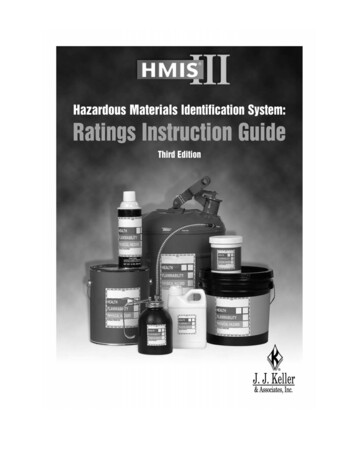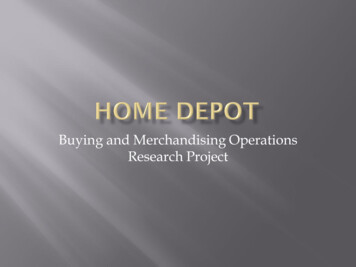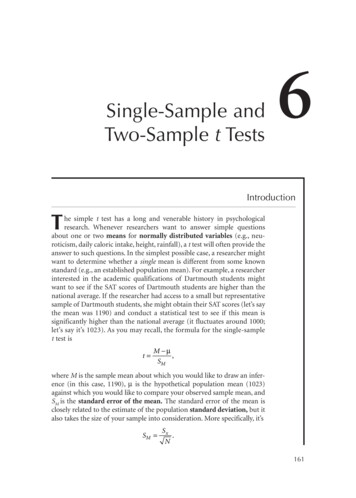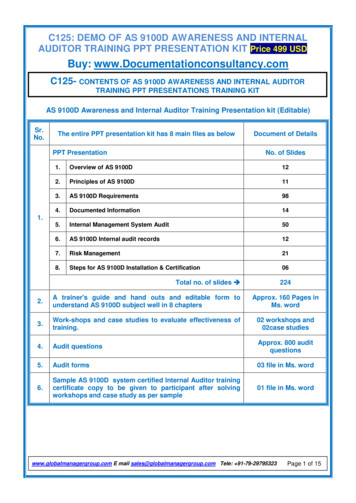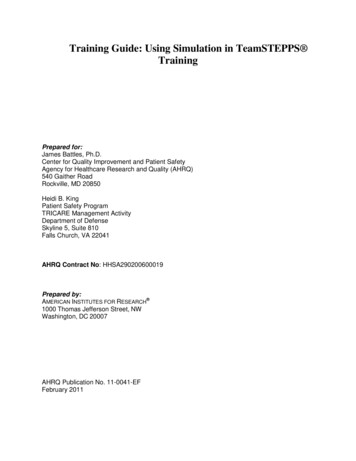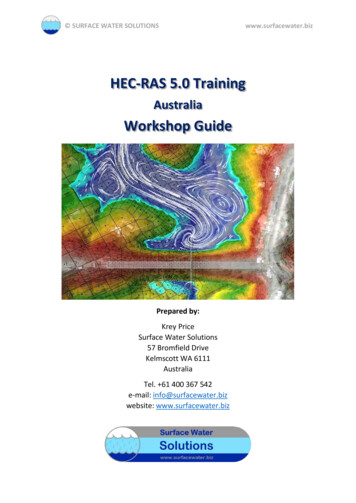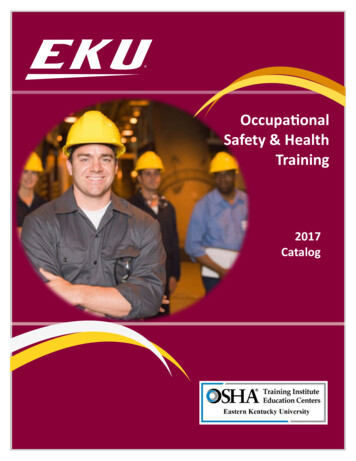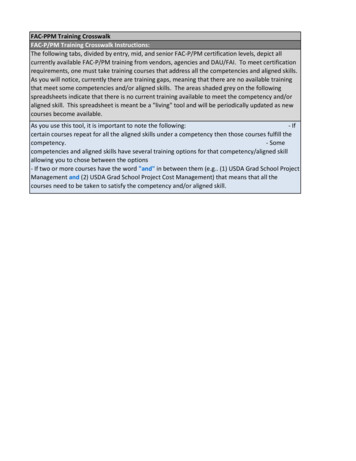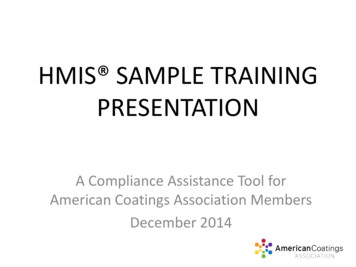
Transcription
HMIS SAMPLE TRAININGPRESENTATIONA Compliance Assistance Tool forAmerican Coatings Association MembersDecember 2014
Let’s Test Your Knowledge! What does the (*) in theHealth block mean?– Chronic health hazard*211 What does the PhysicalHazard block represent?– Self-reactives, organicperoxides, explosives,compressed gases andoxidizers
Introduction and Purpose The HMIS will continue to support compliancefor IN-PLANT LABELING to comply with therequirements of the 2012 revised OSHA HazardCommunication Standard (HCS). This presentation provides:– Overview of Hazard Communication– Brief review of the HCS label elements, safety datasheets (SDSs) and in-plant labeling– Training information to help employees understandthe basic concepts of HMIS
Hazard Communication:The Basic Flowchart
Let’s Review the Label Elements forShipped ContainersProduct IDPictogramSignal WordHazard StatementsPrecautionary Statements
EXAMPLES OF LABELS FROM FACILITY [Insert a label from your facility]
Let’s Review the SDS Requirements Safety Data Sheets (SDS) will gradually replace“old” Material Safety Data Sheets (MSDS) SDS’s must follow a uniform 16-section format1.Identification2.Hazard(s) identification3.Composition - ingredient info4.First-aid measures5.Fire-fighting measures6.Accidental release measures7.Handling and storage8.Exposure control, PPE, exposurelimits9.Physical and chemical properties10.Stability and reactivity11.Toxicological information12.Ecological information13.Disposal considerations14.Transport information15.Regulatory information16.Other
EXAMPLE OF MSDSs and SDSs FROMFACILITY [Insert an MSDS and SDS from your facility]
Relationship BetweenSafety Data Sheets and Labels Container labels provide initial criticalinformation regarding the safe handling and useof hazardous chemicals. SDSs provide more detailed information,essentially a complete summary of all theknown hazard and precautionary informationassociated with the material
Continued Use of “In-plant”Labeling Systems The Revised HCS did not require any changesin the use of IN-PLANT labeling systems likeHMIS The HMIS Hazard Ratings can continue toguide employees on the safe handling anduse of hazardous substances in the workplace
HMIS IntroductionThe HMIS uses a combination of colors,numbers and personal protection equipment(PPE) codes to communicate the hazards of thechemicals you work with and show you how tosafely handle those chemicals.You will find these labels on each chemicalcontainer in your workplace, so it’s important tounderstand what these labels communicate!
HMIS Label Each label will contain informationon:––––Health hazardsFlammabilityPhysical HazardsPPE This label is representative of whatyou may see in your workplace With a quick glance of the label,you should be able to determinehow hazardous the material is andwhat precautions to take.
What Does Each Label Block Tell Me?* 231 Each of the four colors standsfor a different kind of hazard. The numbers indicate howserious the potential hazard isand the White block tells youwhat type of PPE to wearwhen handling the material Ratings are on a scale of 0-4,with 0 denoting a minimalhazard and 4 denoting asevere hazard
What Does Each Label Block Tell Me?* 231 The Blue Health block tellsyou if the chemical is achronic hazard by thepresence of the (*) and thelevel of severity (0-4) of anyacute hazards associatedwith the material.
Health Hazard Ratings There are a lot of ways you can come incontact with a chemical:– You can get it on your hands– It can splash and soak through your clothes or getin your eyes– Or you can breath the dust or vapors
Health Hazard Ratings There are also a lot of different ways thatcontact with a material can affect your health:– Some may cause health problems immediatelyand are called ACUTE hazards. Some examples ofacute hazards are materials that give you aheadache or cause a chemical burn.– Other materials are CHRONIC hazards and maycause health issues with repeated exposure.Cancer and lung disease are two examples.
Health Hazard Ratings The (*) in the Health block is used for healthhazards with clear evidence of health effectsfrom repeated overexposure, includingcarcinogenicity, mutagenicity, reproductivetoxicity, and target organ toxicity. The hazard rating (0-4) in the Health block areused to communicate information onimmediate health effects including irritants,skin sensitizers, corrosives and acute toxicity
EXAMPLES OF HEALTH RATINGS FROMFACILITY 01234Water[Insert an example from your facility][Insert an example from your facility][Insert an example from your facility][Insert an example from your facility]
What Does Each Label Block Tell Me?* 231 The Red Flammability blocktells you about thepresence and severity (0-4)of things that will burn orignite, causing fire orcombustion based on flashpoint and boiling pointdata.
EXAMPLES OF FLAMMABILITY RATINGS 01234Water[Insert an example from your facility][Insert an example from your facility][Insert an example from your facility][Insert an example from your facility]
What Does Each Label Block Tell Me?* 231 The Orange Physical Hazardblock tells you about thepresence and severity (0-4)of materials with theseproperties: self-reactive,organic peroxide, explosive,compressed gas, oroxidizer.
EXAMPLES OF PHYSICAL HAZARDS 01234Water[Insert an example from your facility][Insert an example from your facility][Insert an example from your facility][Insert an example from your facility]
HMIS USE IN FACILITY Who assigns HMIS? What containers is it on? Who to contact if there are questions?
QUESTIONS?
HMIS Introduction. The HMIS uses a combination of colors, numbers and personal protection equipment (PPE) codes to communicate the hazards of the chemicals you work with and show you how to safely handle those chemicals. You will find these labels on each chemical container in your workplace, so it’s important to

